
Abu Mahmoud’s* life in his hometown of Raqqa, Syria hadn’t been normal for a long time. Three years into the civil war, the 35-year-old knew to expect government shellings and volatile checkpoints. Still, children were going to school and some people were working; life was going on.
Then about a year ago, militants from the so-called Islamic State (ISIS) began appearing in the streets armed with Kalashnikovs. As the extremist group established their de facto capital in the city, things changed drastically in Raqqa.
More and more, ISIS’s ideology seeped into every aspect of daily life: The decapitated heads of slain captives were regularly displayed in the city center. Rules against smoking and music were introduced, then tightened. And a more pervasive form of control took shape inside Raqqa’s classrooms.
“Since Da’esh came, the women have to cover up,” Abu Mahmoud said, using the group’s Arabic name. “There is no music. People are going around carrying guns, even the women. Children still go to school but they changed to curriculum. They began to concentrate on religion.”
Reminiscent of the totalitarian regimes of the 20th century, altering school curricula to reflect their extremist views suggests a long-term strategy on the part of ISIS leaders to forge a new generation of caliphate loyalists without even needing to rely on direct recruitment.
“Since [ISIS] came, the women have to cover up. There is no music. People are going around carrying guns.”
By September, Abu Mahmoud said the family faced an ultimatum. They could either accept a new life in Raqqa under the banner of ISIS, he said, or they could flee.
They chose the latter.
Crouched inside a friend’s metal shelter, Abu Mahmoud scruffs his 3-year-old son’s hair and puffs on a cigarette as he recounts their escape from Raqqa. Almost two months ago, they arrived here in Azraq Refugee Camp, about 60 miles east of Jordan’s capital Amman, and 300 miles from their home in northern Syria.
Though reports differ, ISIS militants are believed to control territory stretching up to 35,000 miles across north-eastern Syria and northern Iraq, an area that could be as large as Jordan itself.
As the extremist group carves out more territory, and the U.S. continues months of airstrikes against them, the transformed Syrian conflict is posing new threats to the shattered country’s youngest citizens.
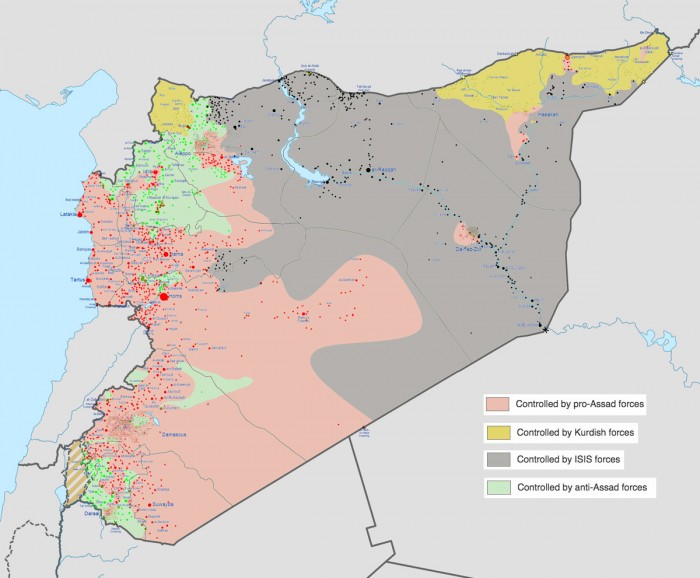
A study released by UK-based Overseas Development Institute (ODI) in September reported international funding pledges to educate an estimated 500,000 out-of-school Syrian children were largely unmet for the coming year, with $200 million in pledges from international donors still unfilled.
As a result, UNHCR’s education budget will fall $235 million short of what it expected, causing a gap that could leave an additional 250,000 Syrian children without access to school.
These numbers reflect an educational environment that’s worse than parts of sub-Saharan Africa. But the study argues this gap poses another risk to young people — the exposure to recruitment and influence by militant groups.
As different factions in the Syrian conflict clamber for new territory, refugees are coming to Jordan to escape not only the physical threat of bombings and detainment, but the psychological challenges of living under the control of militant groups like ISIS.
In these cases, families arrive in Jordan bearing different kinds of war wounds.
Jam-packed with an estimated 80,000 refugees, Jordan’s largest refugee camp Zaatari is no longer accepting new arrivals, except in family reunification cases. Those arriving at the Jordanian border seeking refuge these days are funneled directly to Azraq.
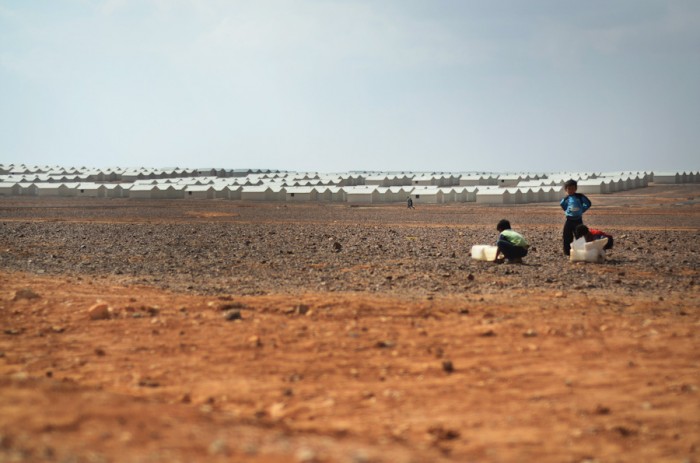
Azraq’s Head of Field Office Bernadette Castel-Hollingsworth said the camp has witnessed a shift in population since August as more refugees from northern, ISIS-controlled provinces like Raqqa and Aleppo are fleeing to Jordan.
The pre-planned camp is just over a year old and built to house up to 130,000 refugees. It opened its doors last April at a time when some 600 refugees were crossing into Jordan daily. But intake has slowed dramatically in recent months with Jordanian authorities upping border restrictions amid security concerns. Reports say the border has been closed altogether at times, and even that authorities have been deporting Syrian refugees back out of Jordan.
Khalid*, another Azraq inhabitant who arrived two months ago from Aleppo’s countryside, corroborated Abu Mahmoud’s account of the militants’ activity in the north.
Just like in Raqqa, once ISIS appeared in areas of Aleppo about a year ago, 40-year-old Khalid said music was silenced, women were covered, and children’s schooling transformed.
“At the schools they are changing the curriculum, they take the teachers and force them to teach this curriculum, and that’s what we escaped. This is what we fled,” he said. “Life becomes very hard, there is no movement, and people are very afraid.”
But beyond ISIS, refugees said another, more familiar danger to young people is also looming — the Syrian government.
“If I get caught by the regime, my head will get cut off, and if I get caught by Da’esh, my head will be cut. I am in danger on both sides,” Khalid said.
According to sources in Arabic media, the Assad government recently issued a decree conscripting Syrian men aged 17-40 into the Syrian Army. Refugees say their family members still inside the country report young men being plucked from government checkpoints and forced to enlist.
Many believe gains by ISIS and other militant groups are driving a more aggressive campaign by the Syrian government to enlist soldiers.
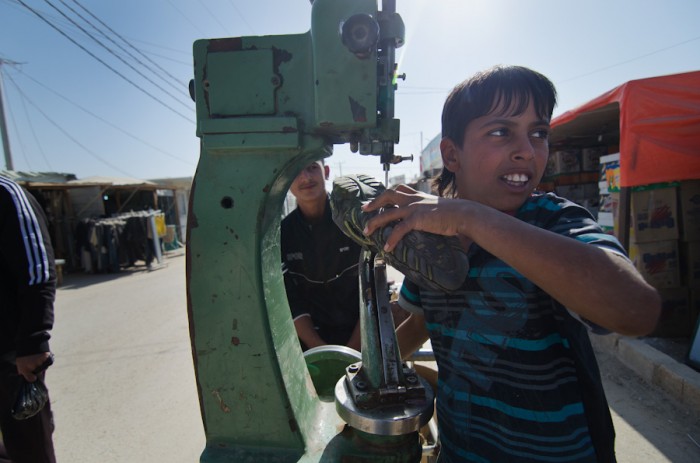
Rizan* is a 56-year-old father of three from Dara’a who’s been in Azraq for three months with his two wives and one child. The southern border town has been under rebel-control since late-April 2013 and is under the control of Free Syrian Army (FSA) factions and al-Qaeda’s Syrian affiliate the Nusra Front, but not ISIS militants.
Rizan said armed groups were difficult to distinguish in Dara’a, so he kept his 22, 20 and 17-year-old sons inside as much as possible. After getting stopped arbitrarily at a government checkpoint, the father said his 20-year-old son was arrested and detained by government forces for seven months, for reasons he still doesn’t understand.
While he believed those joining the FSA and Nusra did so voluntarily, Rizan said he feared his sons would be forced to join ISIS by coercion, or government forces by conscription. In either case, the danger was the same.
“The people are forced into recruitment through Da’esh and the regime — they’re on same level,” he said. “Nusra is not as bad because they don’t recruit you.”
Steven A. Zyck, who co-authored the ODI’s funding study, said the potential for recruitment should serve as an example to the international community of what could happen to Syrians left without access to education.
“Young adults are very vulnerable to these groups who offer a strong sense of belonging, identity and purpose.”
A volatile mix of boredom, non-existent job opportunities and desperation among young Syrians could lead young people straight into the mouth of extremism, both in host communities and inside Syria, Zyck argues.
“We’re talking about this critical time in life where young adults are really are forming an identity, a set of beliefs and principles, and frankly they are very vulnerable to these groups who offer a strong sense of belonging, identity and purpose,” he said. “Right now, no one’s offering that to them except these armed groups.”
Zyck said the study’s connection between radicalization and the lack of educational opportunities is a hard theory to talk about because its effects could cause communities to further isolate young refugees.
“People hear the potential for radicalization and their response is ‘we need to monitor them more closely … get our hands around them,’” he said. “We don’t need token gestures toward de-radicalization, we just need high quality education for student refugee children.”
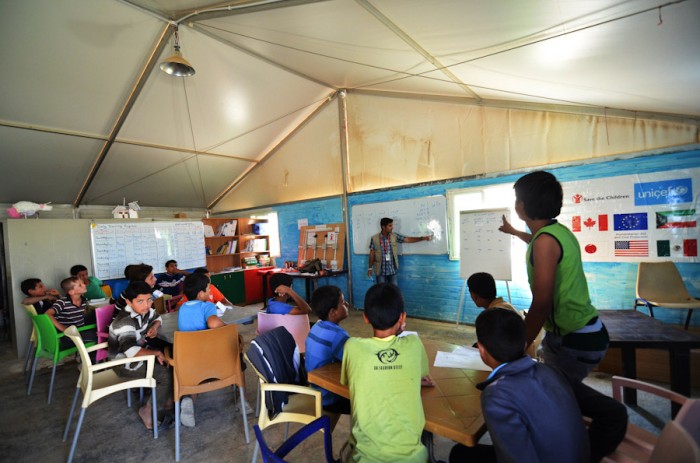
Unlike in Lebanon, where tensions between Syrians and host communities have led some refugees into bloody clashes with Lebanese authorities, Zyck believes the radicalization threat is less apparent in Jordan because the border is more secure and the atmosphere slightly more welcoming to incoming Syrians.
But that could change as more families lean on the desert kingdom’s dwindling resources.
“While we didn’t look specifically there last year and earlier this year, I think there’s definitely a similar risk in a place like Jordan given the similarly high rate of out-of-school children, teenagers and young adults and their degree of frustration,” Zyck said.
In Azraq, paved roads marked with white arrows lead to tidy rows of metal housing. Beyond them, the same shapes dot the horizon for what seems like miles. More than twice the area of its northern counterpart Zaatari, Azraq carries an air of predestined order, extreme efficiency and white dust.
Inside his family’s own metal shelter, Rizan sits with his 17-year-old son — his youngest and the only one who came with the family to Azraq. Their view here is white dirt, white houses and white street paint. But at least at night the skies are quiet.
He still worries his older sons back in Dara’a could be recruited. They were going to university before the war, but they haven’t been to school for years now.
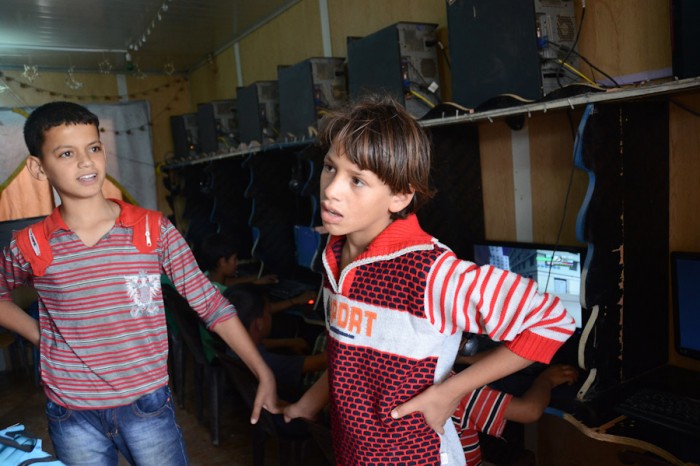
The rise of groups like ISIS has transformed the war in the eyes of the international community, but refugees like Abu Rizan have not forgotten the wounds left by the Syrian government.
He lifts his thick jumper to reveal a oval scar that puckers the skin of his hearty stomach. Here he was hit with shrapnel when a government barrel bomb shattered the bakery he delivered flour to in Dara’a.
“The regime was the one who bombed us but they made us write a testimony to say that armed groups were the ones to bomb us,” he said. “We all hear that the Islamic State is the worst feared enemy, but we feel they and Assad are on the same level, the same enemy.”
*Sources in this story asked that their names be changed for fear of reprisals against them or their families by militants.

